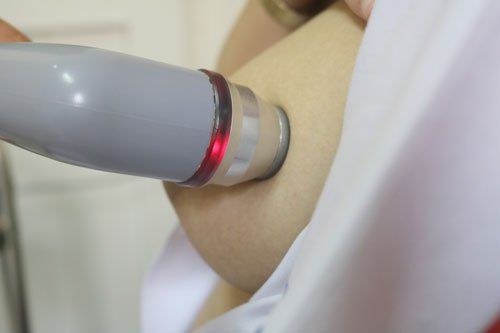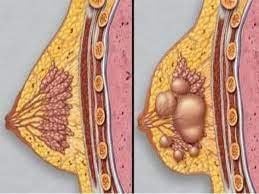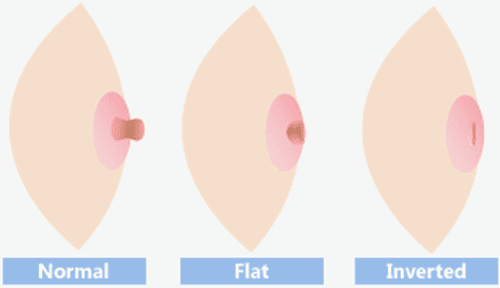This is an automatically translated article.
Continuous blocked milk ducts after giving birth can occur when the mother's milk is trapped inside the milk ducts in the breasts. This phenomenon is quite common in postpartum cases, but it can also make suckling and pumping difficult, even painful for both the baby and the mother. This article will help you better understand the causes of blocked milk ducts and how to fix them.
1. Mechanism of postpartum lactation
During pregnancy, the mother's milk glands have been activated to perform the function of lactation after birth to ensure the supply of nutrients for the baby. Milk will be produced from the milk follicles and follow the milk ducts to the milk-filled sinuses at the back of the areola. When the baby suckles or stimulates the breast, it will help the milk flow out. However, if the milk is blocked, a lump will form at the site of the blockage due to the milk being coagulated, but the milk will continue to be produced, causing the milk ducts to be blocked and stretched, causing compression of the ducts. milk.
2. Continuously blocked milk ducts after giving birth
Continuous blocked milk ducts after giving birth often occur with the condition that breast milk is stagnant and trapped in the milk ducts but cannot be pushed out. This phenomenon will make breastfeeding difficult, even painful for the mother. Continuous blocked milk ducts after giving birth need to be detected and treated promptly to ensure the mother's health so as not to affect breastfeeding.
Although blocked milk ducts after giving birth are quite common, persistent blocked milk ducts are not a normal problem, which can cause many complications for the mother. Mothers with blocked milk ducts, if not treated early, can lead to breast abscess, or mastitis ... Prolonged condition can cause fibroadenoma, which is dangerous for the mother.
In case the mother has a breast abscess, it can cause pus in the mammary gland and cause severe pain. This condition often happens to mothers with blocked milk ducts for more than a week and not treated. If the mother let the blocked milk ducts continuously and for a long time, it can lead to milk loss. Moreover, this situation also makes mothers always feel pain, prolonged stress ... affecting the process of raising and taking care of children. Even many mothers feel depressed after giving birth when they cannot completely treat the continuous blockage of milk ducts. Therefore, if detecting signs of blocked milk ducts, mothers need to find all measures to overcome or see a doctor for timely diagnosis and treatment.
The time of blocked milk ducts can be from 2 to 3 days after giving birth, then the mother's breasts will be tight, heavy and have a burning sensation, the mother may even have fever and infection if This situation persists. At this time, milk is secreted with a feeling of lumps causing engorgement. If the mother is not intervened early, it can lead to blocked milk ducts.

Có nhiều nguyên nhân tắc tia sữa khác nhau mà phụ nữ có thể gặp phải
3. Causes of continuous blocked milk ducts after giving birth
Blocked milk ducts can result from many causes. However, to facilitate diagnosis and treatment, the causes of blocked milk ducts can be divided into two main groups: excess milk due to accumulation in the ducts and prolonged condition leading to blocked milk ducts, and intrinsic milk duct obstruction.
Breast milk in excess also causes blocked milk ducts because the baby does not take all the milk or the mother does not suck the excess milk after the baby is full. With an excess of milk, it leads to milk stagnation in the udder as well as the milk ducts, which causes continuous milk duct obstruction. Not pumping enough milk or not pumping out excess milk can also cause blocked milk ducts. Or the suction power of the breast pump is too weak to suck all the milk out, leaving excess milk remaining in the milk ducts. Babies latch on when breastfeeding improperly, which can cause babies to suckle not enough milk according to their needs as well as excess milk production. Therefore, causing milk to linger in the breasts for a long time, leading to frequent clogged milk ducts. Mothers do not regularly breastfeed their babies, causing milk to stagnate in the breast. There may be a reason why the mother does not breastfeed often or does not pump all the milk. Breast milk is formed from the 6th month of the pregnancy cycle, so after the baby is born, milk has been produced quite a lot in the breasts. However, the milk cannot flow out on its own to feed the baby. If the milk is not stimulated to secrete, it will cause stagnation of milk inside the breast, making the breasts tight and painful, or the mother may have a slight fever. Using a bra that is too tight or wearing a bra that is too tight or carrying a heavy carrier can put pressure on the breasts leading to blocked milk ducts. Moreover, if the mother sleeps on her stomach or does chest exercises, it can also cause the same situation. In addition to the above causes of blocked milk ducts, there may be stress in mothers after giving birth due to changes in the body as well as activities in life. So milk production depends on the mother's mood. If the mother is always in a state of stress, it may slow down the production of the hormone oxytocin, which helps to secrete milk. Therefore, in order to limit the situation of engorgement or even loss of milk, mothers should try to relax so that the mood is always comfortable, creating favorable conditions for the production and secretion of milk to help nourish the baby best.
4. Some physical therapies can help reduce persistent blocked milk ducts after giving birth
Depending on each specific case, there will be treatment methods to help minimize the stagnation of milk that causes mastitis. Physiotherapy has been shown to be able to rapidly dissolve sites of curdled or clotted milk. At the same time, it does not cause trauma to the inflamed glands or the milk duct system. Moreover, this method also does not require the use of pain relievers and systemic anti-inflammatory drugs. Especially during treatment, mothers can still breastfeed their babies normally.
Some physical therapy methods can be applied to the case of continuous blocked milk ducts after giving birth:
Heat therapy has the effect of reducing pain as well as reducing muscle spasms, and at the same time enhancing the blood circulation. anti-inflammatory process and increased tissue regeneration and quick healing of wounds Ultrasonic method has the effect of reducing pain, softening tissues, and increasing biological reactions and increasing metabolism in the tissues. The process of reorganization is taking place quickly. The method of using laser helps to reduce tissue edema, anti-inflammatory and pain relief, and increases fibroblast activity to help collagen synthesis and tissue regeneration.

Sau khi tìm ra nguyên nhân tắc tia sữa thì có thể áp dụng phương pháp laser để điều trị
5. Other measures can help reduce persistent blocked milk ducts after giving birth
Some other ways can be applied at home for persistent blocked milk ducts after giving birth.
If the breast is not too painful, you can feed the baby on the painful breast first, because at this time, the baby will suck with the strongest force to suck milk, thereby helping to unclog blocked milk ducts. Using a hot pack around the breasts to help milk flow more evenly Mothers who often change breastfeeding positions such as sitting, lying down, hugging... will help the milk in the milk ducts be pumped out easily. More Massaging painful breasts regularly can help unclog the milk glands. Mothers should do it regularly and can be combined with a warm compress before breastfeeding to open up the milk ducts, and at the same time, help reduce pain and swelling of the breasts. Some folk experience used in supporting the condition of intermittent milk duct obstruction.
Unclog milk ducts continuously with clove leaves. According to folk tips, Panax ginseng can be used in different states to help improve the condition of the mother's milk ducts after giving birth. Use about 100 grams of fresh fenugreek leaves combined with 50 grams of lettuce leaves, washed and drained. Then, put it in a mortar and pound it and apply it to your chest. When doing this, the mother will feel comfortable and less tense in the breasts. Or you can use 150 grams of Panax ginseng, washed and boiled with 250ml of water to extract drinking water. Mothers should drink for about 3 days to improve blocked milk ducts. Or you can use clove leaves to cook pork rolls. Combine stewed pork leg with papaya or beans along with lentil leaves to create a dairy-friendly dish. Panax ginseng 150g fresh or 30g dry is washed and boiled with water, then remove the leaves to extract the water. Pork leg is also clean and cut into bite-sized pieces. Then put it in filtered water of cloves along with 150 grams of rice to cook porridge with pork feet. Use this porridge for about 2 to 3 days to support blocked milk ducts.
Or use fenugreek leaves to stew with young ribs or meatballs. You can replace the pork leg with young ribs or meatballs to increase the variety of the dish and improve the milk duct blockage. Moreover, this dish also helps to promote health and detoxifies the body. To make this dish, first you need to marinate ground meat with crushed purple onion, with a little fish sauce and seasoning. Then sauté onions to stir-fry the meat and pour in water to boil. When the meat is cooked to the surface, add the cloves and season to taste.
Cabbage can be used as an effective warm compress for blocked milk ducts. Use cabbage leaves washed, then soaked with diluted salt water. Then, boil the cabbage leaves in boiling water and take out the cabbage leaves to apply to the painful breast to improve breast tightness as well as blocked milk ducts. Use sticky rice and wine yeast wrapped in a thin and soft towel and then apply it to the breast with clogged milk ducts. Jackfruit - a fruit that is quite popular and has many health benefits. Moreover, jackfruit leaves are also used to improve the condition of blocked milk ducts. You can take a handful of jackfruit leaves, wash and dry. Then heat the jackfruit leaves on the fire to make the jackfruit leaves hot, then put it on the clogged breast and gently rub it clockwise from the inside to the outside. Do this action for about 2 to 2 days continuously. Use a small handful of dried dandelion leaves about 10 grams, wash and boil with 500ml of water to drink. If using fresh leaves, need about 50 grams and do the same. Use this drink for about 3 days and twice a day to improve blocked milk ducts. In addition, you can use pure green dandelion leaves and use the residue to cover the sore breast. Or you can use dandelion leaves to cook porridge with plain rice. Use this dish twice a day to be effective with blocked milk ducts.
Please dial HOTLINE for more information or register for an appointment HERE. Download MyVinmec app to make appointments faster and to manage your bookings easily.













